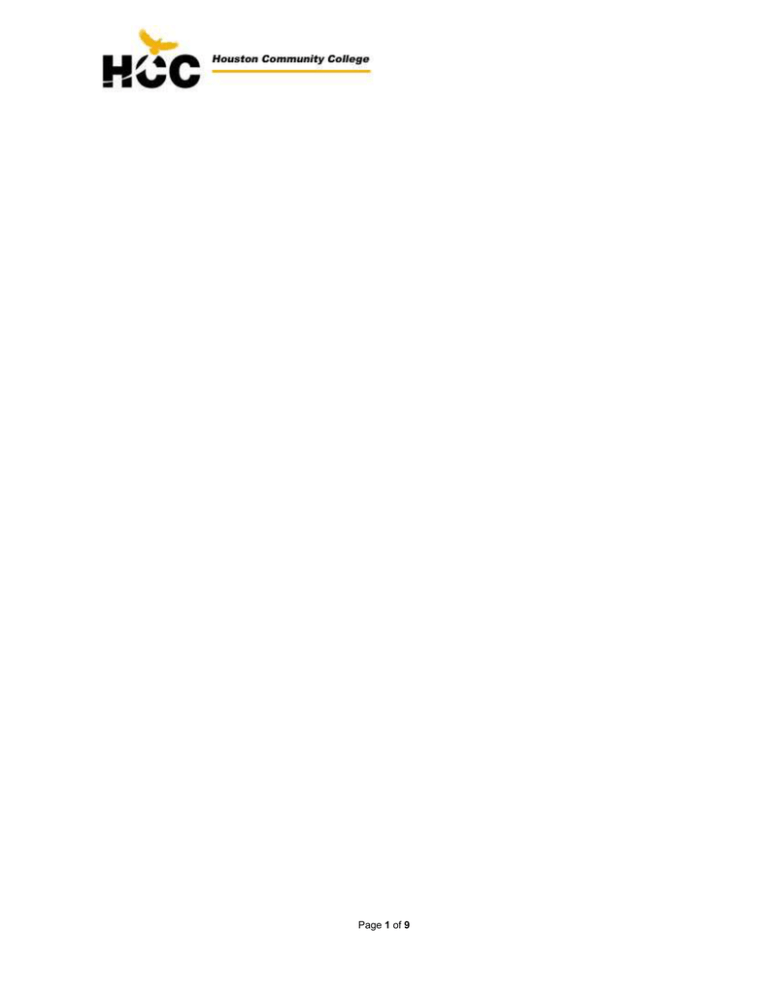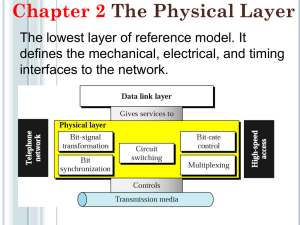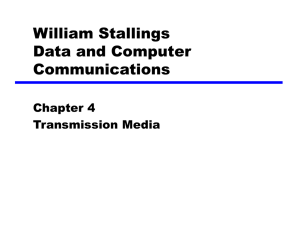CSIR1355 new.doc
advertisement

Page 1 of 9 Page 2 of 9 ARCHITECTURE, CONSTRUCTION & MANUFACTURING TECHNOLOGIES DIVISION INDUSTRIAL ELECTRICITY DEPARTMENT COURSE SYLLABUS COURSE NUMBER: CSIR 1355 COURSE TITLE: Industry Certifications CREDITS: 3 (2 lecture, 3 lab) PREREQUISITE / COREQUISITE: ELPT 1221, ELPT 1329. COURSE DESCRIPTION Preparation for the certifications required by industry. END-OF-COURSE-OUTCOMES Complete industry certification requirements. STUDENT LEARNING OUTCOMES Demonstrate proper safety procedures SLO # 1 Describe the use and applications of network cabling systems SLO # 2 Explain the use and applications of fiber optics SLO # 3 Select proper tools to terminate and test twisted pair, coaxial, and other cable components SLO # 4 Identify electrical code articles pertaining to network wiring applications SLO # 5 COURSE POLICIES Attendance Page 3 of 9 Students are expected to attend classes regularly, and to be on time for every class period. Students can be dropped from a class due to excessive absences. Excessive tardiness may be considered absences. Students are responsible for subjects, assignments, and projects covered during their absences. Consult the Student Handbook for more details or visit http://www.hccs.edu/hccs/current-students/student-handbook Academic Honesty Scholastic dishonesty is treated with the utmost seriousness by the instructor and the College. Academic dishonesty includes, but it is not limited to the willful attempt to misrepresent one’s work, cheat, plagiarize, or impede other students’ scholastic progress. Consult the Student Handbook for more details. Students with Disabilities Any student with a documented disability (e.g. physical, learning, psychiatric, vision, hearing, etc.) who needs to arrange reasonable accommodations must contact the Disability Support Services Office at his / her respective college at the beginning of each semester. Faculties are authorized to provide only the accommodations requested by the Disability Support Services Office. For Central College, call 713 – 718 – 6164. Cell Phones All cell phones must be muted, set to vibrate, or turned off during class. Cell phone activity during class is deemed disruptive to the academic process and will not be tolerated. If you need to make or receive an emergency call, please leave the classroom. Calculators If the course allows the use of a calculator during class, lab projects, and exams, the student is responsible to bring his/her calculator. Cell phones are not calculators, and are not allowed to be used for that purpose during class, tests, or exams. Student ID Students are required to obtain a Student ID. For additional information, consult the Student Handbook. Parking Rules and Regulations Students are required to follow HCC’s regulations regarding parking and permits. For additional information, visit http://www.hccs.edu/hccs/about-hcc/police/parking/parking-rules-and-regulations Books, Tools and Supplies Students are required to purchase and bring to class the required textbooks, tools, notebooks, supplies, and writing instruments as required by the instructor. Dress Code Dress code must be appropriate for the class. Students must dress in a way that clothing and accessories do not compromise their safety, and the safety of others. Proper foot wear is required in all laboratories. Absolutely no sandals or other footwear that exposes the feet will be allowed. Classroom & Laboratory Conduct Proper behavior is expected in all classes and laboratories. Foul language and horseplay are not allowed. Making or receiving cell phone calls during class are not allowed. Sleeping in class is not allowed. Course Withdrawal It is the responsibility of the student to officially withdraw from a course before the official withdrawal deadline. A student who does not withdraw from a course by the deadline will receive an “F” as the final grade. Also note that under Section 51.907 of the Texas Education Code, an institution of higher education may not allow a student to drop more than six courses. COURSE OBJECTIVES Upon completion of this course, the student will: Page 4 of 9 Exhibit knowledge of safety rules and regulations, and demonstrate awareness of hazards in the workplace. Practice safe work procedures around electrical hazards. Identify and describe the characteristics, applications, and configuration of cables and terminations used in network wiring systems. Select proper tools to terminate and test twisted pair, coaxial, and other cable components. Identify electrical code articles pertaining to network wiring applications. Define fiber optic terminology. Explain concepts relating to fiber optics. Describe an identify tools and equipment required to terminate and test fiber optic cables. Identify and describe function of components utilized in fiber optic systems. COURSE TIMELINE, CONTENTS & ACTIVITIES Page 5 of 9 WEEK # 1: COURSE RULES AND ORIENTATION Introduction Purpose of the course Overview of course syllabus Course policies Required materials, textbook(s), supplies, and resources (if applicable) Disability Support Services Registration, schedules, receipts, and student ID Importance of updating and maintaining student data (Name, Address, ID #, phone numbers, emails) Parking rules and regulations Classroom and laboratory safety Course withdrawal, Official Day of Record, and last day for withdrawal Course tests, quizzes, exams, and assignments Course grading policies Instructor information Campus orientation WEEK # 2: Introduction to the types of copper cables and connectors. Introduction to the types of tools used for termination of connectors. Introduction to the different types of connector terminations. Introduction to the types of copper cable testers. Introduction to the types of copper cable termination panels. Introduction to the color code for copper cables. WEEK # 3: Watch film on cable pulling procedures. Introduction to connectorization of Twisted Pair cabling systems. Introduction to the tools used for Twisted Pair cabling system. Make up a four twisted pair T568A cable connectorization. Terminate cable using a RJ45 unshielded connector. Use the cable tester to test the accuracy of termination. Turn in the results of cable termination. WEEK # 4: Make up a four twisted pair T568B cable connectorization. Terminate cable using an RJ45 unshielded connector. Use the cable tester to test the accuracy of the termination. Turn in the results of the cable termination. WEEK # 5: Make up a four twisted pair USOC cable connectorization. Terminate cable using a RJ45 unshielded connector. Page 6 of 9 Use the cable tester to test the accuracy of the termination. Turn in the results of the cable termination. Introduction to the shielded twisted pair cable connector. WEEK # 6: Make up a four twisted pair T568A, T568B, and USOC connectorizations using shielded twisted pair cable. Terminate cable using a RJ45 shielded connector. Use the cable tester to test the accuracy of the termination. Turn the results of the cable terminations. Introduction to the 25 twisted pair unshielded cable. Terminate the 25 twisted pair cable to the M61 and the 110 twisted pair. Termination blocks using the 66/110 punch down tools. WEEK # 7: Introduction to Coaxial cable and types of connecters. Makeup a Coaxial cable using a F-type connector and RG59 cable. Makeup a Coaxial cable using a F-type connector and RG6 cable. Makeup a Coaxial cable using a BNC connector and RG59 cable. Makeup a Coaxial cable using a BNC connector and RG6 cable. Use the cable tester to test the accuracy of the terminations. Turn in the results of the terminated cables. WEEK # 8: MIDTERM EXAM Make up a T568A, T568B, USOC cable using four twisted pair cable shielded/unshielded cable and shielded/unshielded connectors. Use the twisted pair cable tester to test the accuracy of the terminations. Turn in the results of the terminated cables. Make up a Coaxial cable for F-type and BNC connectors using RG59 and RG6 Coaxial cable. Use the Coaxial cable tester to test the accuracy of the terminations. Turn in the results of the terminated cables. WEEK # 9: Introduction to fiber optics. Introduction to fiber optics fibers single mode and multi-mode. Introduction to fiber optics connectors ST and SC. Introduction to fiber optics tools for connectorization. Introduction to fiber optics fiber and connectors. WEEK # 10: Watch DVD on Fiber Optic Safety. Watch DVD on Introduction to Fiber Optics. Page 7 of 9 Practice stripping the buffer coating off SM fibers. Practice stripping the buffer coating off MM fiber. WEEK # 11: Watch DVD how fiber optic fibers are made. Watch DVD on how fiber optic cables are laid in the field. Strip the buffer coating off a MM AND SM fiber. Practice cleaning the fiber after it has been stripped. Dry fit the fiber to the MM connector. WEEK # 12: Watch DVD on how to connectorize a fiber optic fiber. Connectorize a Single Mode fiber. Clean and scribe (cut) the fiber. Practice polishing the fiber. WEEK # 13: Connectorize a Multi-Mode fiber. Clean and scribe (cut) the fiber. Practice polishing the fiber. WEEK # 14: Connectorize a Multi-Mode fiber. Connectorize a Single Mode fiber. Practice polishing the MM and SM fibers. Check fibers for accuracy using the Fiber TV Tester. WEEK # 15: Watch DVD on how to test fiber optic fiber using an OTDR (Optical Time Domain Reflectometer). Watch DVD on how to electrically fuse fiber also manually splice fiber. Practice connectorization of the fibers. Practice polishing the fibers. Check fibers for accuracy using the Fiber TV Tester. WEEK # 16: FINAL EXAM Connectorize a Single Mode fiber. Polish the fiber. Check the fiber for accuracy using the Fiber TV Tester. Connectorize a Multi-Mode fiber. Polish the fiber. Check the fiber for accuracy using the Fiber TV Tester. Page 8 of 9 Turn in the result of the fibers. Page 9 of 9




